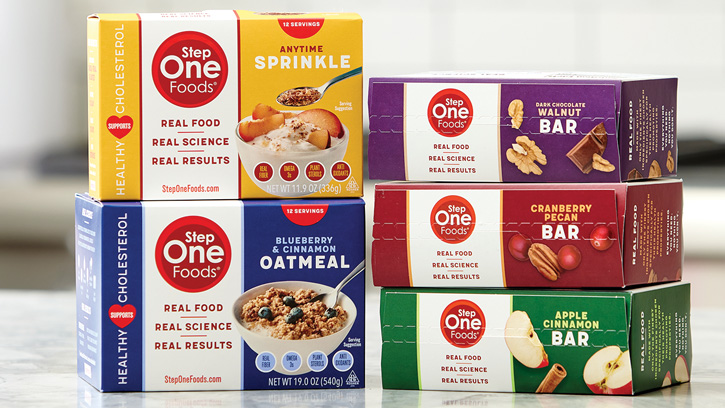A Heart Health Balancing Act
Nutraceuticals | APPLIED SCIENCE
With high cholesterol and high blood pressure prevalent on both the maternal and paternal sides of my family, the issue of cardiovascular health is near and dear to my heart (pun intended). According to the Centers for Disease Control (CDC), I’m one of about half of all Americans (47%) who have at least one of three key risk factors for cardiovascular disease (CVD): high blood pressure, high cholesterol, and smoking. Between 2015 and 2018, 126.9 million American adults had some form of CVD. In addition, in 2018, coronary heart disease (CHD) was the leading cause of deaths attributable to CVD in the United States (42.1%), followed by stroke (17.0%), high blood pressure (11.0%), heart failure (9.6%), diseases of the arteries (2.9%), and other CVD (17.4%).
While family genetics can’t be overcome, nutrition and diet play integral roles in fighting CVD. For example, the Mediterranean diet, the Dietary Approach to Stop Hypertension (known as the DASH diet), and plant-based dietary patterns have been associated with lower atherosclerotic disease risk in observational studies (Kirkpatrick and Maki 2021). These eating lifestyles emphasize higher intakes of plant-based foods, lean animal protein sources, and non-tropical oils, while limiting intake of sugar-sweetened products, refined grains, and processed meats.
Recently, the American Heart Association (AHA) released updated dietary guidance to improve cardiovascular health. The scientific statement encourages balance and emphasizes the importance of “the whole package” of what someone eats over the course of a day or week (Merschel 2021). “What’s really important is the balance of everything together that has the biggest impact on cardiovascular health,” said Alice H. Lichtenstein, who led the writing committee for the AHA scientific statement.
The report advises that a heart-healthy dietary pattern includes the following behaviors:
- achieving and maintaining a healthy body weight
- eating a variety of fruits and vegetables
- choosing whole grains rather than refined grain products
- choosing healthy sources of proteins, mostly from plant sources (legumes and nuts); regularly eating fish and seafood; substituting nonfat and low-fat dairy products in place of full-fat versions; and for people who eat meat, choosing lean cuts rather than processed forms
- using liquid plant oils instead of tropical oils and animal fats or partially hydrogenated fats
- choosing minimally processed over ultra-processed foods
- minimizing foods and beverages with added sugar
- choosing foods with little or no added salt
- limiting alcohol consumption or not starting to drink alcohol
- adhering to heart health guidance regardless of where food is prepared or consumed (Lichtenstein et al. 2021).
Dietary Interventions
Elizabeth Klodas, a preventive cardiologist, founded Step One Foods, which offers a line of snack bars and breakfast products, to make it easier for patients to change their diets and reduce their risk for heart disease. Step One products are designed to help lower cholesterol levels using several well-documented cardio-friendly nutrients, including dietary fiber, omega-3 fatty acids, antioxidants, and plant sterols, and research supports the company’s claim.
When Step One products were eaten twice a day as a substitute for similar items (two four-week phases with a rest period in between), a 9% reduction in low-density lipoprotein (LDL) cholesterol was observed, high-density lipoprotein (HDL) cholesterol went up slightly, and blood sugar fell slightly (Kopecky et al. 2018). Step One snacks and breakfast foods supplied at least 1,800 mg of the omega-3 fatty acid alpha-linolenic acid (ALA), 5 g of fiber, and 1 g of plant sterols per serving.
Plant sterols have a chemical structure similar to that of cholesterol, which means they can block cholesterol absorption and help lower total cholesterol as well as LDL cholesterol. Several meta-analyses show a dose-response relationship with intakes of 1.5–3 g/day of plant sterols lowering LDL cholesterol by 7.5% to 12% (Trautwein et al. 2018).
Dietary fiber, both insoluble and soluble, helps lower cholesterol as well as blood pressure. Fruits, vegetables, nuts, seeds, and whole grains are all sources of dietary fiber. In fact, Murphy and Schmier (2020) found that if whole grain intake was increased to meet recommended levels (an increase of 2.24 servings of whole grain per day), the estimated direct medical cost savings from reduced risk of heart disease in the United States was $21.9 billion annually. Further, the researchers found that even small increases in whole grain intake can translate to substantial medical cost savings. An increase of just 0.25 servings of whole grains per day was associated with saving $2.4 billion annually.
Omega-3 fatty acids help reduce inflammation and lower triglycerides while raising HDL cholesterol. Omega-3 fatty acids (eicosapentaenoic acid and docosahexaenoic acid) are highest in fatty fish. The AHA recommends eating two servings of fish per week to help reduce heart disease and stroke risk. The heart association issued a science advisory in 2019 saying prescription fish oil supplements were also a safe and effective way to lower triglycerides.
The omega-3 fatty acid ALA can be found in flaxseed and walnuts. Walnuts, in particular, are unique among nuts in that they are an excellent source of ALA. Recently, in a two-year study of an elderly population, Rajaram et al. (2021) showed that eating a handful (1–1.5 oz) of walnuts daily lowered LDL cholesterol and total cholesterol among those aged 63 and up.
Heart Health Up-and-Comers
While consumers recognize the nutrients in fruits, nuts, and whole grains as heart healthy, there are some less-familiar ingredients that may also help with the formulation of heart-healthy products.
Probiotics. You wouldn’t normally associate probiotics with heart health, but in a pilot study, Derosa et al. (2020) demonstrated that a supplement containing Lactobacillus plantarum (LPLDL, OptiBiotix Health), arginine, coenzyme Q10, and vitamin B1 could be helpful in improving high normal blood pressure and hypercholesterolemia. (Normal blood pressure is less than 120/80 mmHg. High normal is in the range of 130–139 and/or 85–89.) The probiotic Lactobacillus plantarum (LPLDL) enhances bile salt hydrolysis, which causes the liver to pull cholesterol from the blood in circulation, ultimately decreasing blood cholesterol and blood pressure.
In January 2021, OptiBiotix announced continued commercial developments in North America on behalf of its subsidiary ProBiotix Health with a non-exclusive license agreement for LPLDL with Genuine Health Inc., a Canadian-based natural health company, for the development of a cardiovascular health product in Canada and the United States. Genuine Health will submit its products to Health Canada with the goal of obtaining a specific health claim for the probiotic supplement and cardiovascular health in the Canadian market.
Vitamin K. Beneficial for bone and cardiovascular health, vitamin K aids in the prevention of arterial calcification. Bellinge et al. (2021) highlighted the potential importance of vitamin K (K1 and K2) for atherosclerotic cardiovascular disease (ASCVD). In the prospective cohort study, they observed the risk of ASCVD was inversely associated with diets high in vitamin K1 or K2. Compared with participants with the lowest vitamin K1 intakes, participants with the highest intakes had a 21% lower risk of ASCVD-related hospitalizations. The same relationship was seen with vitamin K2; the risk of ASCVD-related hospitalizations with the highest intakes was 14% lower than participants with the lowest vitamin K2 intake.
A balanced, heart-healthy diet with some of these whole foods and ingredients and a healthy lifestyle are so important to help take control of cardiovascular health. I can personally attest to that. A shift in my diet, as well as focusing on daily exercise, has helped keep me off blood pressure medication for the past three years.
Learning Objectives
- Understand the impact of cardiovascular disease on public health.
- List elements of the American Heart Association’s recommended dietary pattern.
- Recognize well-researched heart-health nutrients as well as ingredients with potential cardio benefits.






